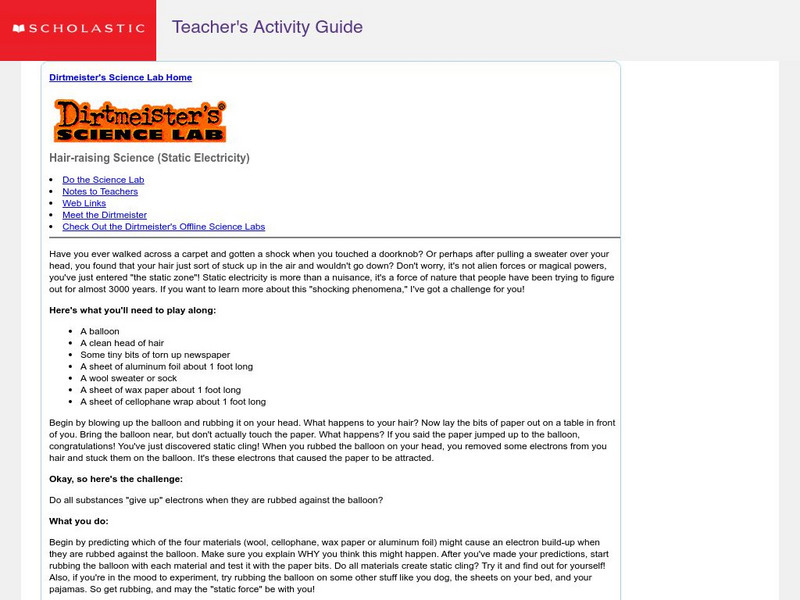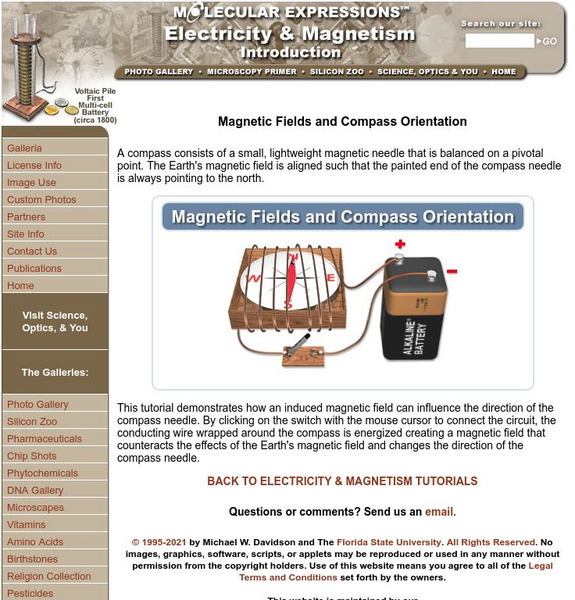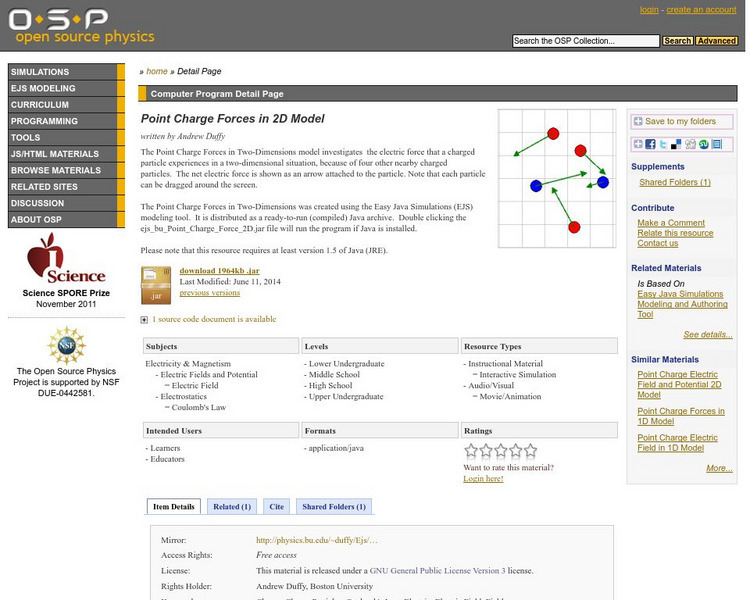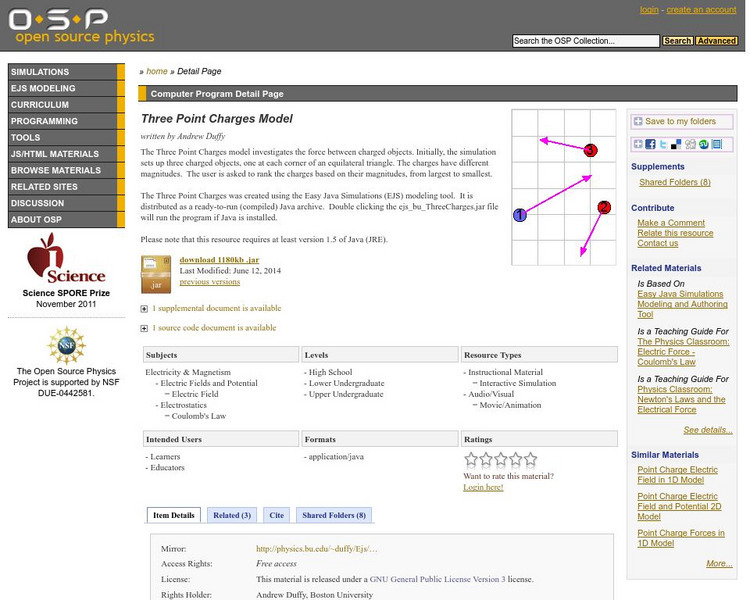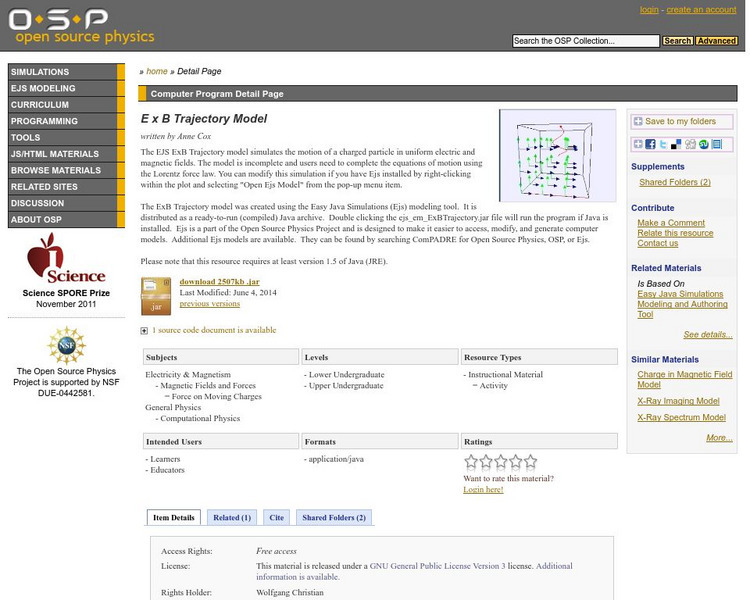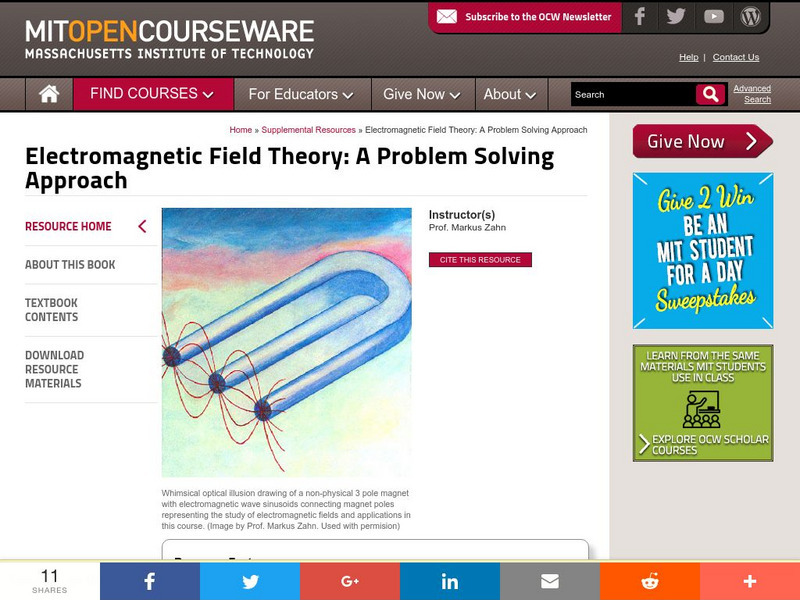Science and Mathematics Initiative for Learning Enhancement (SMILE)
Smile: Electromagnets
This lesson plan contains several activities designed to help the student understand the magnetic effects of an electrical current.
Scholastic
Scholastic: Dirtmeister's Science Lab: Hair Raising Science
A great experiment to show students how electrons move by static electricity. This site includes web links, a challenge question, and notes for the teacher.
Florida State University
Florida State University: Molecular Expressions: Magnetic Fields and Compass Orientation
Simulate the creation of an induced magnetic field through the use of a simple electric circuit. An interactive demonstration is included.
Exploratorium
Exploratorium: Science Snacks: Charge and Carry
This site from The Exploratorium Museum is a full description of a short activity. An electrophorus plate and a Leyden jar are made. The electrophorus is charged by induction. Its charge is transferred to the Leyden jar by conduction...
American Association of Physics Teachers
Com Padre Digital Library: Open Source Physics: Point Charge Forces in 2 D Model
In this simulation, examine the electric force that a charged particle gains from nearby charged particles in a two-dimensional state. See the net electric force shown as an arrow attached to the particle.
American Association of Physics Teachers
Com Padre Digital Library: Open Source Physics: Point Charge Forces in 1 D Model
Virtual simulation investigating the electric force that one charged particle exerts on another. Plot a graph of the electric force as a function of position.
American Association of Physics Teachers
Com Padre Digital Library: Open Source Physics: Three Point Charges Model
In this simulation, investigate the force between charged objects. Rank three charged objects of different magnitudes, then create a method to determine the ranking of the charge magnitudes. Finally, devise a new method of determining...
Physics Aviary
Physics Aviary: Practice Problems: Force Electric Between Two Particles
Students must find the force on one charge caused by a second charge.
CK-12 Foundation
Ck 12: Force on an Electric Current in a Magnetic Field
[Free Registration/Login may be required to access all resource tools.] Students learn how a magnetic field affects moving charged particles or an electric current carried by a wire.
McREL International
Mc Rel: Whelmer #31 Activity: Static Charged 2x4s
A simple activity that investigates the basic principles behind static electricity. The activity is in lesson plan format that meets NSES standards.
Physics Aviary
Physics Aviary: Millikan Oil Drop Lab
This lab is designed to have students determine the charge on a series of oil drops that are suspended in an electric field. Students will measure the size of the drop in an effort to determine the force gravity on the drop. They will...
American Association of Physics Teachers
Com Padre Digital Library: Open Source Physics: E X B Trajectory Model
Simulate the motion of a charged particle in electric and magnetic fields, and then complete the equations of motion using the Lorentz force law.
Concord Consortium
Concord Consortium: Stem Resources: How Electrons Move
A collection of interactive activities and games to explore how electric fields and magnetic fields move electrons and charged particles in directions that can be planned. Understand that knowing how to control the movement of electrons...
Massachusetts Institute of Technology
Mit: Open Course Ware: Resources: Electromagnetic Field Theory
College-level electrical engineering textbook starting from the Coulomb-Lorentz force law on a point charge. Sample problems that reinforce the content are found at the end of each chapter. Includes downloadable excerpts of the textbook...
Concord Consortium
What Are the Factors That Affect How Strongly Objects Interact With Each Other?
Exploration of models of electric field to explain how charged objects interact with other objects via simulations, practice and activities. Sponsored by Concord Consortium and the CREATE for STEM Institute at Michigan State University.
Famous Scientists
Famous Scientists: Charles Augustin De Coulomb
A short biography about Charles Coulomb, known for developing Coulomb's law, the definition of the electrostatic force of attraction and repulsion.
Concord Consortium
The Concord Consortium: Molecular Workbench: Lorentz Force 3 D
Adjust the magnetic field intensity and the particle speed in this simulation to observe the affect the movement of the particle.
ClassFlow
Class Flow: Coulomb's Law
[Free Registration/Login Required] This resource provides information about Coulomb's law.
CK-12 Foundation
Ck 12: Coulomb's Law
[Free Registration/Login may be required to access all resource tools.] Students investigate how electric force, charge, and distance all relate to each other in Coulomb's Law. Presents Coulomb's Law, the SI unit for charge, the...
Concord Consortium
Concord Consortium: Target Game
Steer a charged particle to a target. Place particles in the game and charge them to guide a positive projectile around obstacles to hit a target. You can place any number of charged objects in any location to steer the positive particle...
Concord Consortium
Concord Consortium: Target Game
Steer a charged particle to a target, and observe forces and fields.
Concord Consortium
Concord Consortium: How Electrons Move
Being able to control the movement of electrons is fundamental for making all electronic devices work. Discover how electric and magnetic fields can be used to move electrons around. Begin by exploring the relationship between electric...
Concord Consortium
Concord Consortium What Are the Factors That Affect How Strongly Objects Interact With Each Other?
Activity 2 of this module explains How do factors like distance and amount of charge affect interactions between objects? The activity investigates the effect that the distance between two charged objects has on the strength of the...
Science and Mathematics Initiative for Learning Enhancement (SMILE)
Smile: Electrostatics
A teacher lesson plan which includes activities pertaining to common methods of charging objects - induction, conduction, and friction.



